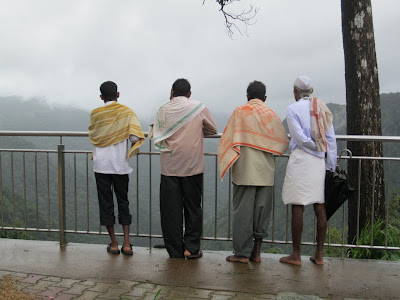Yeah, it's been a while again. Sorr about the absence. (And sorr about the absence of y in "sorry.") I've been really busy traveling around with Ben and then Maria and Nadeen, which means limited Internet access. I check my email and update Facebook regularly, I just don't spend enough time at a computer to actually write a blogpost. So here's a short one.
I visited my good friend Prashanth a few days ago. He has moved from the adivasi (tribal) villages of Narmada Valley, Madhya Pradesh to the elephant-infested area around Katur village, Karnataka. Yes, elephant-infested. He now works for the Wildlife Research and Conservation Society (WRCS) in man-elephant conflict. Elephants are lured from the forest by the delicious scent of man's agricultural livelihood and devour vast swaths of rice paddies. So the humans respond as they usually do when under attack: shooting the enemy. Clearly all this is no good for either side of the war. Prashanth's job is to draft a peace treaty and get both parties to ratify. Inter-species conflict resolution, if you will.
How does one resolve an inter-species conflict? Well, Prashanth researches various eco-friendly elephant deterrents, and he disseminates information to the farmers about the deterrents that work. For example, elephants hate chilies. Can't take the heat, I suppose. So one plan would be to plant a field of chilies in between the rice paddies and forest to create a buffer zone (or to continue the metaphor, a DMZ). Prashanth's organization will provide a particularly potent variety of chilies for the farmers to plant. Another thing elephants hate are bees, so farmers could start beekeeping. Not only would honey bring them an additional source of income, they'd have an entire army of stinging soldiers to defend the crops from intruding elephant marauders. And the benefit for the elephants is, of course, not getting shot. The elephants have plenty to eat in the forest anyway, so it's not like they're really getting the stiff end of the deal.
Prashanth's work is particularly important because this problem exists all over India, not only in Karnataka. Assam sees the highest number of man-elephant conflict incidents--many of which end in deaths of humans, not only elephants--but it is difficult to experiment with deterrents there simply because the elephant population is way too large. North Karnataka provides a good, small sample size. If Prashanth's techniques work here, then they can be tested in areas with a denser population of elephants.
Plus Prashanth gets to track elephants in the wild as part of his job. Which is effing awesome. ...I just hope he never gets killed by an elephant in musth.
While I visited Prashanth, we drove on his motorcycle into the Western Ghats to Jog Falls, the highest uninterrupted plunge falls in India. The primary forests of the Ghats were so unbelievably, beautifully lush, as they always are during monsoon, and the mountain air was refreshing and cool! A great, much-needed break from the heat and humidity of the plains. Despite a minor spill (that felt oddly slow-motion; I was able to tuck my knees into my chest before the motorcycle fell on top of me), we survived the day almost intact (I scratched up my elbow when I fell off the bike) (thank god for helmets!). Here are some pictures:

At the hydropower viewpoint, men admire the wonder that is electricity generation. They did not understand how a river could generate electricity, so Prashanth and I explained it to them. Ok fine, maybe Prashanth did most of the explaining--I don't speak Kannada! In any case, these guys were in awe, and I loved it. It's true, electricity really is an amazing thing! I need to be in awe of infrastructure more often.

We scrambled over slippery rocks in the rain to the top of the waterfalls. This is the vertigo-inducing view over the falls. This picture doesn't really do it justice because I was too nervous about dropping my camera to actually position it correctly.





I do remember you being quite in awe of electrical infrastructure.
ReplyDeleteGranted, it was in the awesome Kinnaur Valley, and we were in awe of pretty much everything we saw :)
Love, Hélène